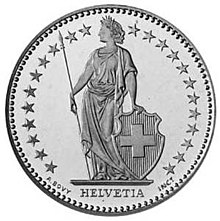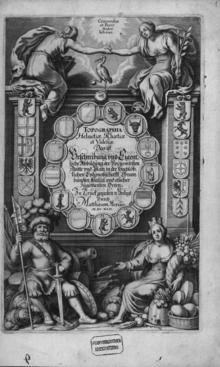Helvetia
The allegory is typically pictured in a flowing clothing, with a spear and a shield emblazoned with the Swiss flag, and commonly with braided hair and a wreath as a symbol of confederation.
On 14 September 1672, a monumental baroque play by Johann Caspar Weissenbach was performed in Zug, entitled Eydtgnossisch Contrafeth Auff- und Abnemmender Jungfrawen Helvetiae.
In the final scene, Christ appears to punish the wayward damsel, but the Mother of God and Bruder Klaus intercede, and the contrite sinner is pardoned.
Thus, the name appears on postage stamps, coins, and other uses; the full name, Confœderatio Helvetica, is abbreviated for uses such as the ISO 3166-1 alpha-2 and vehicle registration code CH, and the ccTLD, .ch.
Notably, translations of the term Helvetia still serve as the name for Switzerland in languages such as Irish, in which the country is known as An Eilvéis, Greek, in which it is known as Ελβετία (Elvetia) and Romanian, in which it is known as Elveția.


